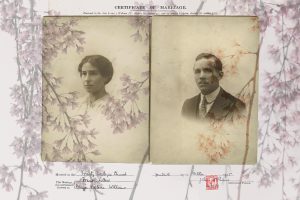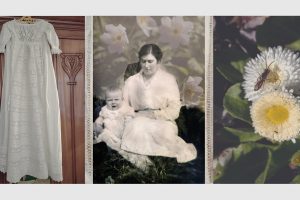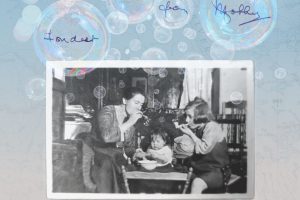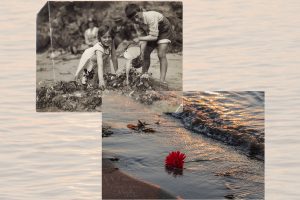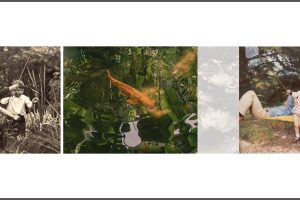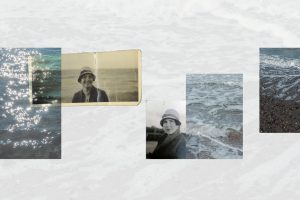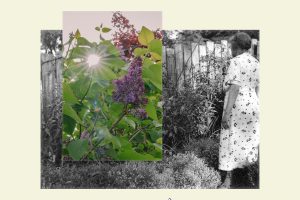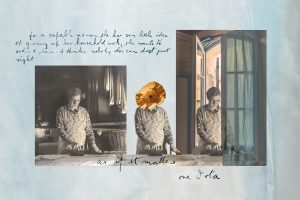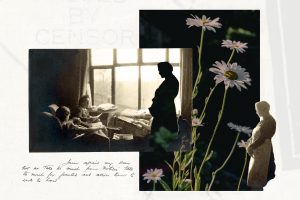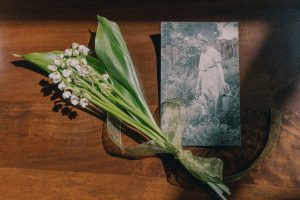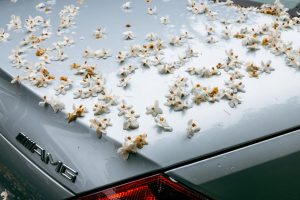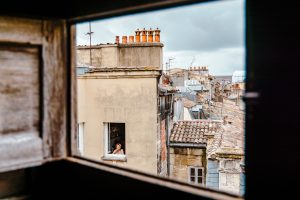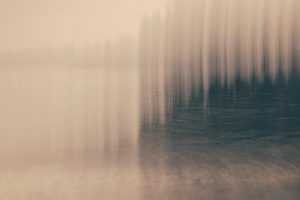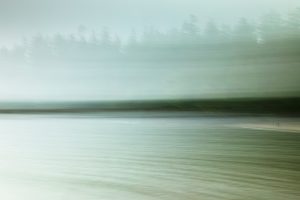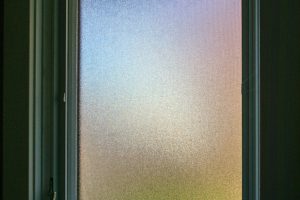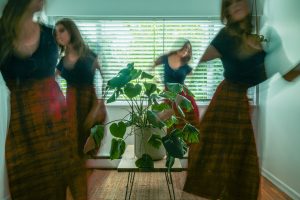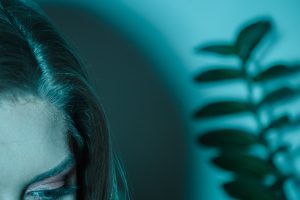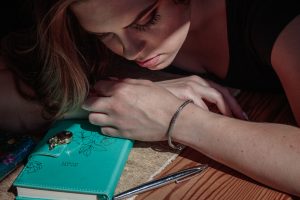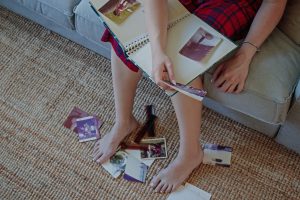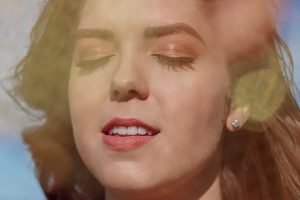
My personal project, "The Garden of Maggie Victoria", explores the evolution of memory and female representation through the story of my great-grandmother, forgotten within my family after her premature death in 1943. It integrates photos by my great-grandfather, archival letters and my contemporary, nature-oriented images to create collages reviving my ancestor’s legacy. Maggie Victoria’s life as a mother, wife, and nurturer of people and plants was both ordinary, and extraordinary. Anchored in a personal meditation, the series invites us to consider questions of heritage, grief and passing time that affect everyone. My great-grandmother married Frank Sellers in Chorley, Lancashire in the midst of World War I. Although we have their marriage certificate recording this fact, we do not have any photos from the wedding. These images mark their engagement. Interestingly, certificates at the time were validated with an actual stamp. This series is the winner of the Women Seen By Women category (non-pro) in the 20th Julia Margaret Cameron Awards, 2023.

After marrying in 1915, Maggie Victoria and Frank would have two daughters and a son. In the centre, Maggie Victoria with one of her children, in an image captured by Frank and embellished with Spring flowers by me. On the left is one of the christening dresses passed down the years; I wore this myself as a baby. The dress photo is by my mother, Anne, who still has the garment. The seams from the dress link these images made by three generations of my family. The flowers and insect on the right I captured in Vancouver, into which I combined a "baby" brooch once owned by Maggie Victoria, and later bequeathed by one of her daughters. I would like to believe in the idea of generational continuity. I wonder how far down the years Maggie Victoria expected these treasures to persist.

I was delighted to come across this fun black and white image of my great-grandmother in the mid-1920s blowing bubbles with two of her three young children. "Fondest Love From Mother" was how Maggie Victoria regularly signed letters to her eldest daughter. The new bubbles — many, many bubbles — were blown and captured on a hot summer's afternoon in our garden last year. I incorporated elements of sky and land (the map) to convey the transfer of affection down the generations and across continents.

Unusually for this series, we believe that the old beach photo top left was made by Maggie Victoria herself and entered in a photography competition, since her name and address were written in her hand on the back. Those details are now a part of the image I made during an exquisite sunset on Jericho Beach in Vancouver, bottom right. Pictured are my grandmother Doris and great-uncle Brian, her second and third children, making their own flower garden in the sand. I appreciate the flow of water and continuity between the two images.

Maggie Victoria and Frank’s three children are pictured on the left “fishing” in the garden, while a younger version of me is “fishing” on holiday with my grandad on the right. Frank’s waterlilies separate us between the decades. What connects us, though, aside from our apparent joy at fishing, is that our parents and grandparents very much valued the benefit of education and made sure we did too. In the case of their two daughters - my grandmother and great-aunt - Maggie Victoria and Frank made sure they studied beyond school and both went on to have careers of their own - quite forward-thinking for the 1930s and 40s. Certainly they had advantages that Maggie Victoria never had, and both parents worked hard for their family.

Two very different images of Maggie Victoria taken on the same day at the seaside in the mid-1920s by her husband Frank. One carefree, the other much less so. A pivotal point in her adult life - looking back to happier times, and ahead to troubles both personal and political. I was at first puzzled why the photo of Maggie Victoria smiling (left) would be torn and folded - until my mother pointed out that someone likely kept it with them in their wallet. To make the wave images, I sought out the Pacific Ocean at different times and in varying conditions.

Maggie Victoria was proud of the garden she and her husband Frank created at their Lancashire home. In a letter to Gladys, her eldest daughter, we see the first signs of her failing health. She talks of her speed working in the garden being only “a slow one to-day”. I included my own image of lilac since she also complained of not having sufficient bunches of the flowers to give to friends that year. A month later, she would be gone.

This photo of Maggie Victoria ironing is one of the first images I ever saw of her, and it is striking that she is pictured doing housework - a theme that is familiar throughout Frank's images. In one of his letters to his eldest daughter, Frank expresses alarm that his wife insists on keeping the house in order even though she is ailing. He writes: "For a capable woman, she has very little idea of giving up her household work, she wants to order + plan + thinks nobody else can do it just right as if it matters one iota."

"I am afraid my Dear that we take too much from mothers, take too much for granted and allow them to work too hard." An extract from a letter sent by "Uncle John" (real name William) in Australia to my grandmother Doris on learning of the tragic early death of her mother Maggie Victoria - his sister and my great-grandmother - in 1943. Maggie Victoria died in May and my grandmother's letter letting Uncle John know reached him only in mid-July. His reply, written immediately, took several more months to arrive from Australia, intercepted by the censor, as were all letters at the time. In the analogue image by my great-grandfather Frank, Maggie Victoria appears as usual to be taking care of everyone, including her grown children and her husband, whose propped-up feet are seen bottom right. I set her apart in the collage to draw attention to her for once, and to foreshadow her imminent absence, along with some sunny yet dark flowers.

The last photo taken of Maggie Victoria, tending to her garden. Her nurse wrote a letter to Maggie Victoria’s eldest daughter Gladys just a couple of days before her mother’s death. In it, she wrote that the “beautiful perfume” of two vases of lily of the valley were flooding the bedroom where her patient was resting.

Fallen blossoms after a summer rainstorm in Vancouver, Canada. This image exemplifies how I seek out the poetry in the quotidien, and look for beauty others may miss. After the Rain was selected to be included in Shutter Hub's 2022 Yearbook publication of 100 photographers working around the world now. It was also selected to be part of the RPS Summer exhibition in 2023.

Seen from the top of the ancient Porte Cailhau, a gate guarding the city of Bordeaux in south-west France. Out of the corner of my eye I saw the woman smoking in the window, and knew I only had a split second to capture her, adding a focal point to the already interesting rooftops in the old town. In my street photography, I like to draw attention to moments of pause or joy in a busy world, and capture them so that we may take a moment of respite or reflection.

Part of a small series entitled "Half Moon Bay, Ucluelet", I made this abstract image on a remote shoreline on the west coast of Canada, as a response to the shock of the first Covid lockdown and the lifting of restrictions in summer 2020. While the Vancouver Island landscape and its features have permanence and substance, I chose to present them in an abstract, fleeting manner as a reminder to myself that the privilege of visiting and being a part of such places could evaporate again at any time. The image was made in camera using ICM. Winner of the Abstract category of the 16th Julia Margaret Cameron Awards, 2021.

Part of a small series entitled "Half Moon Bay, Ucluelet", I made this abstract image on a remote shoreline on the west coast of Canada, as a response to the shock of the first Covid lockdown and the lifting of restrictions in summer 2020. While the Vancouver Island landscape and its features have permanence and substance, I chose to present them in an abstract, fleeting manner as a reminder to myself that the privilege of visiting and being a part of such places could evaporate again at any time. The image was made in camera using ICM. Recipient of Honourable Mentions in the Abstract and the Landscapes & Seascapes categories of the 16th Julia Margaret Cameron Awards, 2021.

Shot during the first lockdown of the pandemic, I found the abstract, blurred colour behind the window a perfect metaphor for how we were all of a sudden cut off from the vibrant world we were used to, and perhaps took for granted. I longed for the outside but realized I needed to find moments of joy and optimism in my newly confined space at home.

The following five images are drawn from my constructed reality series “A/Part”. This staged series imagines how it feels to live burdened by a secret, and explores the resulting impact on personal identity. It offers a visual interpretation of a journey through feelings including difference, shame, isolation, self-sufficiency, acceptance and, finally, resolution. Using a constant – if sometimes abstract or fragmented – female subject, A/Part reflects the push and pull between interior and exterior life. As the sequence progresses, the images shift between movement and stillness, and between blur and focus, mirroring alternating states of turmoil and clarity. The series is a reflection of how the norms imposed by “polite society” may negatively impact our sense of self – especially among women - and contemplates the riches to be attained by reclaiming one’s own story and living fully. This first image, "Difference", deals with the turbulence of feeling “different” from other people and consequently unable to properly root oneself in the world. It is a multiple exposure created from four separate images made using a slow shutter speed while directing the female subject to move around the room.

This image is drawn from my constructed reality series “A/Part”, which imagines how it feels to live burdened by a secret, and explores the resulting impact on personal identity. This image tackles the feeling of shame: The learning of a secret, the realization of a fact. The feeling that everyone else must know, too, and is making judgements. And so we retreat. How much of this shame is real, and how much is imagined, we may never know. But it follows us, darkly, until we are able to challenge it and finally discard it.

Drawn from my staged series "A/Part", this image addresses the discovery of a secret and the quest to get to the bottom of the story, while fearing what may lie ahead. As such, the subject is at once close to the light, but still in the shadows.

A renewed determination to invent a past, and also a future for oneself, knowing that a mysterious, missing person could have been a part of it. Drawn from my constructed reality series, "A/Part".

The final image in my series "A/Part". At last. A lifetime of knowing and not knowing, of hiding from others for self-preservation. We can move on. The warmth of the sun is a blessing.























